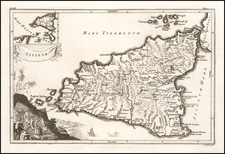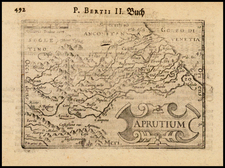Straits of Messina / Cariddi
The title "Wahre Bildtnuss des Felsens Scijlla, und des gefährlichen ohrts Charybdis in Calabria, wie er diser zeit anzusehen" translates in English to "The true depiction of the Scylla Rock, and the dangerous place Charybdis in Calabria, as it can be seen at this time."
This 17th-century German view provides a fascinating image of a portion of the Coast near Messina in Sicily, inspired by two formidable features of the classical world, Scylla and Charybdis. These landmarks, situated in the Strait of Messina that separates Sicily and Calabria in Southern Italy, have a rich backstory that dates back to ancient Greek mythology. They're not just geographical features but also represent a profound allegory.
Scylla and Charybdis were known as sea monsters in Greek mythology, symbols of unavoidable peril. The dilemma faced by sailors attempting to navigate the narrow strait between these hazards gave birth to the idiom "between Scylla and Charybdis," signifying the necessity to choose the lesser of two evils.
Scylla, portrayed as a rock or reef, is situated on the mainland side of the Italian strait, while Charybdis, often visualized as a treacherous whirlpool, is on the Sicilian side. The document, by designating Scylla as a rock, attaches a sense of palpable reality to the myth. On the other hand, Charybdis is referred to as a "dangerous place," acknowledging its notorious reputation.
Interestingly, Charybdis's contemporary name is Cariddi. This transformation is a testament to the Italian language's preference for avoiding difficult consonant clusters, thus making the name easier to pronounce for locals. This linguistic evolution is similar to how "Alexandra" becomes "Alessandra" in Italian.
Mathaus Merian (1593-1650) was the father of engraver Matthäus the Younger, and of the painter, engraver, and naturalist Maria Sibylla Merian. He was born in Basel, Switzerland and trained in engraving in Zurich. After a time in Nancy, Paris and Strasbourg, he settled in Frankfurt. While there, he worked for Johann Theodor de Bry, the publisher and son of the travel writer. In 1617, he married Maria Magdalena de Bry, Johann Theodor’s daughter. In 1623, Merian took over the de Bry publishing house upon the death of his father-in-law. Merian’s best known works are detailed town views which, due to their accuracy and artistry, form a valuable record of European urban life in the first half of the sixteenth century









![[ Kingdom of Naples ] Regni Neapolitani Verissima Secundum Antiquorum et Recentiorum Traditionem Descriptio, Pyrrho Ligorio Acut.](https://storage.googleapis.com/raremaps/img/small/85528.jpg)
![(Roman Region) Latium Campanje en Samnium et de Omleggende Landstreeken [Latium, Campania, and Samnium and the surrounding regions.]](https://storage.googleapis.com/raremaps/img/small/93839.jpg)

![(1779 Eruption of Mt Vesuvius) Vue de la Sommite et du Crate du Vesuve au moment de l'Eruption... []View from the Summit of Vesuvius Crater at the Moment of the Eruoption]](https://storage.googleapis.com/raremaps/img/small/91151.jpg)
![Tabula Aphricae II [Sicily & Sardinia shown]](https://storage.googleapis.com/raremaps/img/small/89727.jpg)
